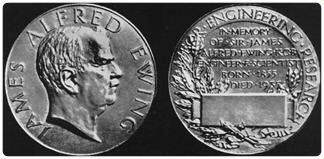
|
|
||||||||
James Alfred Ewing
He eventually returned to Scotland to be the Professor at Dundee. He was horrified by the slum dwellings that had appeared, and contrasted the conditions endured by the working classes unfavourably with those of similar people in Japan. He protested that there was no reason why a working man's children should have an infant mortality rate three times greater than his more prosperous neighbours. He worked with the local authorities and mill owners to make life more pleasant for everyone, particularly with regard to improving the sewerage systems.
He was appointed Professor of Mechanism and Applied Mechanics at Cambridge in 1890 and held the post until 1903. 'From the bleaker regions of the Tay, Cambridge seemed a sort of Southern Paradise - a lotus eating land.' Ewing also hoped his wife's health might improve with a move to the south.
He was a personal friend of Charles Parsons and also worked with him on developing the steam turbine. During this time, Ewing published his famous book on 'The Steam Engine and other Heat Engines'.
In 1897 he took part in the trials of the experimental vessel Turbinia when she achieved the unprecedented speed of thirty-five knots over the measured mile. During his tenure the school grew at an enormous rate: a Tripos was instituted (1892) a laboratory founded (1894) and in 1899 a new wing was opened in memory of John Hopkinson.

|
|
|